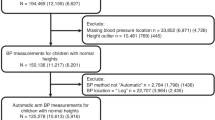Abstract
Background
Children who were born prematurely, those with a very low birthweight, or who have survived the neonatal intensive care unit (NICU) are at risk for the development of hypertension and chronic kidney disease (CKD), and thus require blood pressure screening less than 3 years of age, per American Academy of Pediatrics (AAP) 2004 and 2017 guidelines.
Methods
We reviewed the practice patterns of a large pediatric health care system and assessed adherence to the AAP clinical practice guidelines on blood pressure measurements in children less than 3 years of age for hypertension and CKD with the following risk factors: prematurity, very low birthweight, and a neonatal intensive care setting encounter. This retrospective chart review included a total of 9965 patients with a median gestational age of 34 weeks.
Results
Overall, 38% of patients had at least one blood pressure measured less than 3 years of age. Primary care accounted for 41% of all outpatient encounters and 4% of all blood pressure measurements. Surgical specialties (i.e., ophthalmology, otolaryngology, and orthopedics) accounted for many non-primary care visits and were less likely than medical specialties (i.e., cardiology and nephrology) to obtain a blood pressure measurement (p < 0.0001).
Conclusions
This study of a large healthcare system’s practice revealed a lack of basic screening for hypertension in a population known to be at risk for hypertension and CKD.

Similar content being viewed by others
References
Martin JA, Hamilton BE, Osterman MJK, Driscoll AK, Drake P (2018) Births: final data for 2016. Natl Vital Stat Rep 67:1–55
Martin JA, Hamilton BE, Osterman MJ, Driscoll AK, Mathews TJ (2017) Births: final data for 2015. Natl Vital Stat Rep 66:1
Carmody JB, Charlton JR (2013) Short-term gestation, long-term risk: prematurity and chronic kidney disease. Pediatrics 131:1168–1179
White SL, Perkovic V, Cass A, Chang CL, Poulter NR, Spector T, Haysom L, Craig JC, Salmi IA, Chadban SJ, Huxley RR (2009) Is low birth weight an antecedent of CKD in later life? A systematic review of observational studies. Am J Kidney Dis 54:248–261
Hinchliffe SA, Sargent PH, Howard CV, Chan YF, van Velzen D (1991) Human intrauterine renal growth expressed in absolute number of glomeruli assessed by the disector method and cavalieri principle. Lab Investig 64:777–784
Hsieh EM, Hornik CP, Clark RH, Laughon MM, Benjamin DK, Smith PB Jr, Best Pharmaceuticals for Children Act-Pediatric Trials Network (2014) Medication use in the neonatal intensive care unit. Am J Perinatol 31:811–821
National High Blood Pressure Education Program Working Group on High Blood Pressure in Children and Adolescents (2004) The fourth report on the diagnosis, evaluation, and treatment of high blood pressure in children and adolescents. Pediatrics 114:555–576
USRDS (2017) USRDS annual data report: epidemiology of kidney disease in the United States. Available from https://www.usrds.org. Accessed 16 Jul 2018
Flynn JT, Kaelber DC, Baker-Smith CM, Blowey D, Carroll AE, Daniels SR, de Ferranti SD, Dionne JM, Falkner B, Flinn SK, Gidding SS, Goodwin C, Leu MG, Powers ME, Rea C, Samuels J, Simasek M, Thaker VV, Urbina EM; Subcommittee on screening and management of high blood pressure in children (2017) Clinical practice guideline for screening and management of high blood pressure in children and adolescents. Pediatrics 140. https://doi.org/10.1542/peds.2017-1904
Kaelber DC, Pickett F (2009) Simple table to identify children and adolescents needing further evaluation of blood pressure. Pediatrics 123:e972–e974
Maranon R, Reckelhoff JF (2013) Sex and gender differences in control of blood pressure. Clin Sci (Lond) 125:311–318
Theodore RF, Broadbent J, Nagin D, Ambler A, Hogan S, Ramrakha S, Cutfield W, Williams MJ, Harrington H, Moffitt TE, Caspi A, Milne B, Poulton R (2015) Childhood to early-midlife systolic blood pressure trajectories: early-life predictors, effect modifiers, and adult cardiovascular outcomes. Hypertension 66:1108–1115
Author information
Authors and Affiliations
Corresponding author
Ethics declarations
We obtained Institutional Review Board approval to perform a review and analysis of de-identified patient data.
Conflict of interest
The authors declare that they have no conflict of interest.
Rights and permissions
About this article
Cite this article
Shah, L., Hossain, J., Xie, S. et al. Poor adherence to early childhood blood pressure measurement guidelines in a large pediatric healthcare system. Pediatr Nephrol 34, 697–701 (2019). https://doi.org/10.1007/s00467-018-4132-y
Received:
Revised:
Accepted:
Published:
Issue Date:
DOI: https://doi.org/10.1007/s00467-018-4132-y




